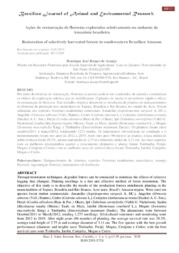Ações de restauração de florestas exploradas seletivamente no sudoeste da Amazônia brasileira.
Ações de restauração de florestas exploradas seletivamente no sudoeste da Amazônia brasileira.
Author(s): ARAUJO, H. J. B. de
Summary: Por meio de técnicas de restauração, florestas exauridas podem ser conduzidas de maneira a minimizar os efeitos da exploração seletiva que as modificaram. O plantio de mudas é um método rápido e eficaz de restauração de florestas. Este trabalho objetiva descrever os resultados de plantios de enriquecimento de florestas de produção nos municípios de Xapuri, Brasiléia e Rio Branco, no estado do Acre. Foram utilizadas dez espécies florestais madeireiras comerciais: Amarelão (Aspidosperma vargasii A. DC.), Angelim (Ormosia arborea (Vell.) Harms), Cedro (Cedrela odorata L.), Cerejeira (Amburana acreana (Ducke) A. C. Sm.), Freijó (Cordia alliodora (Ruiz & Pav.) Oken), Ipê (Tabebuia serratifolia (Vahl) G. Nicholson), Itaúba (Mezilaurus itauba (Meisn.) Taub. ex Mez), Jatobá (Hymenaea courbaril L.), Mogno (Swietenia macrophylla King) e Timbaúba (Enterolobium maximum Ducke). Os plantios foram entre outubro/2011 a março/2012, totalizando 1273 mudas. Os tratamentos silviculturais de condução e o monitoramento foram nos anos de 2012 a 2019. Após oito anos (96 meses) ao plantio, a taxa média de sobrevivência foi de 29,3%, altura total média de 2,75 m e diâmetro médio de 3,11 cm. As cinco espécies com os melhores desempenhos quanto a crescimento (diâmetro e altura) foram Timbaúba, Freijó, Mogno, Cerejeira e Cedro; com as melhores taxas de sobrevivência foram Timbaúba, Jatobá, Cerejeira, Mogno e Cedro. Through restoration techniques, degraded forests can be conducted to minimize the effects of selective logging that changed. Planting seedlings is a fast and effective method of forest restoration. The objective of this study is to describe the results of the production forests enrichment planting in the municipalities of Xapuri, Brasiléia and Rio Branco, Acre state, Brazil's Amazon region. Were used ten species forest timber commercials: Amarelão (Aspidosperma vargasii A. DC.), Angelim (Ormosia arborea (Vell.) Harms), Cedro (Cedrela odorata L.), Cerejeira (Amburana acreana (Ducke) A. C. Sm.), Freijó (Cordia alliodora (Ruiz & Pav.) Oken), Ipê (Tabebuia serratifolia (Vahl) G. Nicholson), Itaúba (Mezilaurus itauba (Meisn.) Taub. ex Mez), Jatobá (Hymenaea courbaril L.), Mogno (Swietenia macrophylla King) e Timbaúba (Enterolobium maximum Ducke). The plantations were between October/2011 to March/2012, totaling 1,273 seedlings. Silvicultural treatments and monitoring were from 2012 to 2019. After eight years (96 months) of planting, the average survival rate was 29.3%, average total height of 2.75 m and average diameter of 3.11 cm. The five species with the best growth performance (diameter and height) were Timbaúba, Freijó, Mogno, Cerejeira e Cedro; with the best survival rates were Timbaúba, Jatobá, Cerejeira, Mogno e Cedro.
Publication year: 2020
Types of publication: Journal article
Unit: Embrapa Acre
Keywords: Acre, Amarelão, Amazonia Occidental, Amazônia Ocidental, Amburana Acreana, Angelim, Aspidosperma vargasii, Brasiléia (AC), Brazilian copal, Cedrela Odorata, Cedro, Cerejeira Amarela, Cordia Alliodora, Enterolobium maximum, Essência Florestal, Exploração seletiva, Floresta, Forest management, Forest regeneration, Freijó Louro, Handroanthus serratifolius, Hymenaea Courbaril, Ipê Amarelo, Itaúba, Jatobá, Madera tropical, Manejo florestal, Mezilaurus Itauba, Mogno, Muda, Ormosia arborea, Plantación, Planting, Plantio, Producción de plántulas, Regeneración forestal, Regeneração, Rio Branco (AC), Seedling production, Swietenia Macrophylla, Tabebuia Serratifolia, Timbaúba, Tropical wood, Western Amazon, Xapuri (AC)
Observation
Some of Embrapa's publications are published as ePub files. To read them, use or download one of the following free software options to your computer or mobile device. Android: Google Play Books; IOS: iBooks; Windows and Linux: Calibre.
Access other publications
Access the Agricultural Research Database (BDPA) to consult Embrapa's full library collection and records.
Visit Embrapa Bookstore to purchase books and other publications sold by Embrapa.

